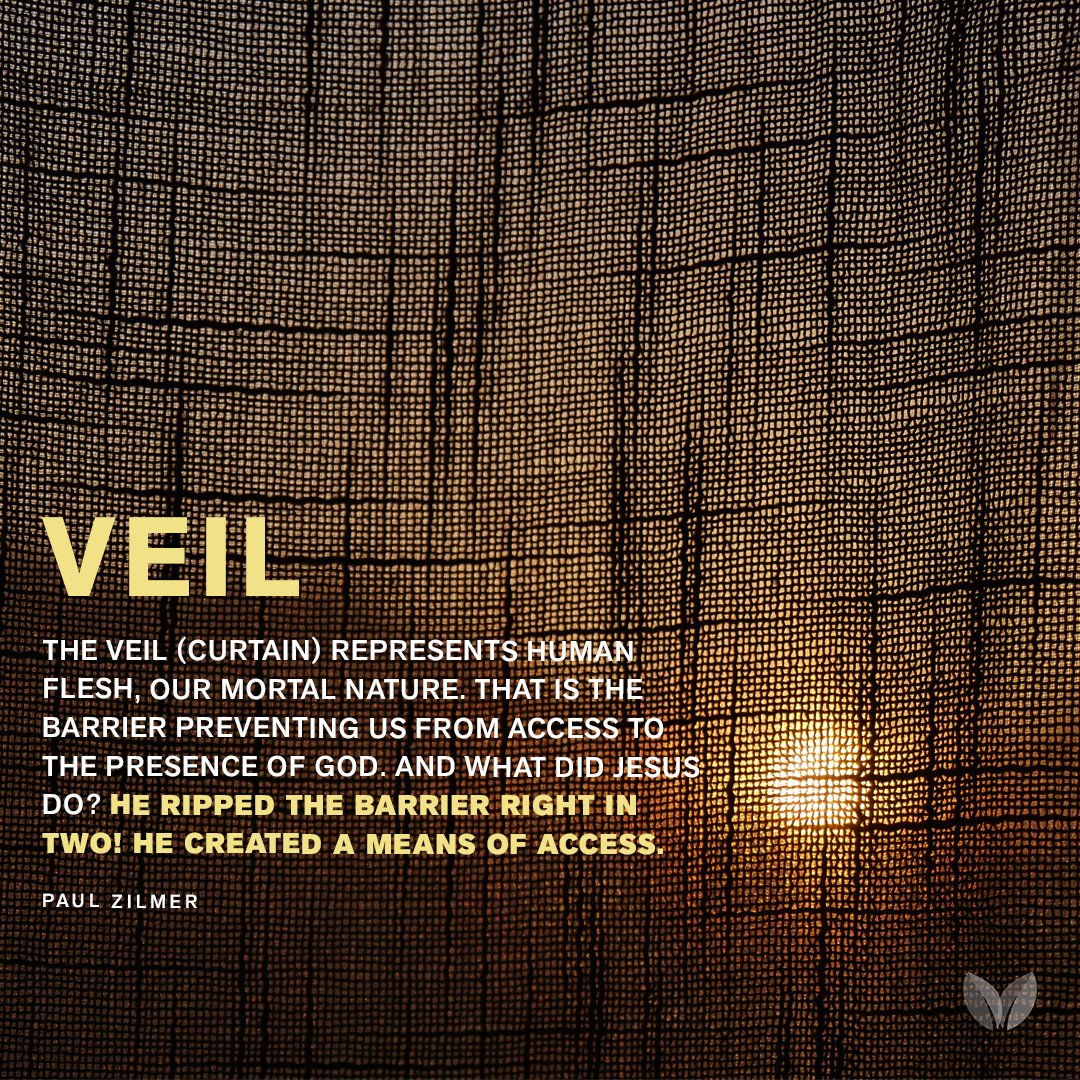Veil
In the Tabernacle, built by Moses at the Lord’s command, a veil (or curtain) separated the Holy place from the Most Holy. The priests went regularly into the Holy—to offer incense, to tend the golden lampstand, to lay out the “bread of the presence”. But the Most Holy, which contained the Ark of the Covenant, was only entered once a year, only by the High Priest, only on the Day of Atonement. The details are found throughout Exodus and Leviticus.
Bible students have always considered the Tabernacle, and the later Temple, as symbolic. They didn’t just make it up. In the New Testament, Hebrews 9:1-10 says it explicitly. It’s worthwhile to take a minute and re-read those verses.
You will recall what happened to the curtain in the Temple when Jesus died: “And Jesus cried out again with a loud voice and yielded up his spirit. And behold, the curtain of the temple was torn in two, from top to bottom. And the earth shook, and the rocks were split.” (Matthew 27:50-51) This wasn’t just random—it was significant. With all that was going on the day of the crucifixion, this detail about the curtain was significant enough to be recorded by Mark and Luke as well as Matthew.
But once again, we don’t have to guess. Hebrews again provides the interpretation. “Therefore, brothers, since we have confidence to enter the holy places by the blood of Jesus, by the new and living way that he opened for us through the curtain, that is, through his flesh…” (Hebrews 10:19-20) We’re explicitly told: the veil (curtain) represents human flesh, our mortal nature. That is the barrier preventing us from access to the presence of God. And what did Jesus do? He ripped the barrier right in two! He created a means of access. The actual event in the Temple wasn’t just a result of the earthquake—it had an enormously important meaning. This is just one piece of the Bible’s teaching about what is often called “the atonement”.
I was reminded of all this, reading today in the prophet Isaiah.
And he will swallow up on this mountain
the covering that is cast over all peoples,
the veil that is spread over all nations.
He will swallow up death forever;
and the Lord GOD will wipe away tears from all faces,
and the reproach of his people he will take away from all the earth,
for the LORD has spoken. (Isaiah 25:7-8)
We don’t have to wait all the way till we get to Hebrews to understand what the veil is. Isaiah says it right here: It is death. The veil spread over all nations—no one is exempt. But what a wonderful hope is expressed here! Death will be swallowed up forever! This is a promise of immortality. And where does it happen? “On this mountain.” Where’s that? The only mountain of interest to Isaiah is Mount Zion – Jerusalem. Where Jesus died, establishing the way for death to be swallowed up forever.
But. People still die, don’t we. All of us. So what gives?
The next chapter in Isaiah gives us the answer. “Your dead shall live; their bodies shall rise. You who dwell in the dust, awake and sing for joy! For your dew is a dew of light, and the earth will give birth to the dead.” (Isaiah 26:19) The answer is that God’s people who have died, will live again! (Others, we find earlier in the chapter, will not: “They are dead, they will not live; they are shades, they will not arise; to that end you have visited them with destruction and wiped out all remembrance of them.” (verse 14) Those folks are gone forever.)
The Christian hope is the hope of resurrection. This is the very heart of the gospel. And of course, nothing about God’s plan changed between Old and New Testaments. The one hope provided by God has always been the hope of resurrection.
And the result is that the Lord God will wipe away the tears from all faces. Right in this statement we see that, though death would be swallowed up, there would continue to be grief—we would continue to die—until God’s dead arise.
Besides the links to the veil in Hebrews and the gospels, other links are worth pursuing. Have a re-read of Daniel 12:1-2, 1 Corinthians 15:50-57 (and indeed that whole chapter), noting Paul’s quotation of Hosea 13:14, which in itself has links to the Isaiah passage. And of course, as you may have recognized, the hope stated at the very close of the Bible, reflects the words of Isaiah:
And I heard a loud voice from the throne saying, “Behold, the dwelling place of God is with man. He will dwell with them, and they will be his people, and God himself will be with them as their God. He will wipe away every tear from their eyes, and death shall be no more, neither shall there be mourning, nor crying, nor pain anymore, for the former things have passed away.” (Revelation 21:3-4)
Every tear wiped away – because the veil of our mortality is no more. Some, but not all, will be the beneficiaries. “The one who conquers will have this heritage, and I will be his God and he will be my son.” (verse 7) For those who persist in sin, “their portion will be in the lake that burns with fire and sulfur, which is the second death.” (verse 8)
This is an enormous subject, in fact it’s the heart of the Christian message, way too big for one short posting like this. But as I read in Isaiah today, I was prompted to reflect on this wonderful, amazing hope set before us. The veil being ripped up, abolished, swallowed up. By the plan of God, put in place from the very beginning: the redeeming work completed by God’s Messiah, the Lord Jesus. Take a moment to wonder at this: He has opened the way through the curtain. And therefore, as the writer to the Hebrews encourages, “Let us draw near, in full assurance of faith... For he who promised is faithful.” (10:22-23) God’s dead will live. He will swallow up the veil of death. Forever. Guaranteed: “For the Lord has spoken.”
Love, Paul


